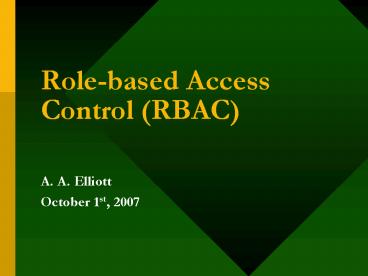Rolebased Access Control RBAC - PowerPoint PPT Presentation
1 / 23
Title:
Rolebased Access Control RBAC
Description:
Case #1: 5 users 5 tables = 10 grants. Case #2: 100 users 100 tables = 200 grants ... clinical medicine, environmental research, air traffic control, and avionics. ... – PowerPoint PPT presentation
Number of Views:57
Avg rating:3.0/5.0
Title: Rolebased Access Control RBAC
1
Role-based Access Control (RBAC)
- A. A. Elliott
- October 1st, 2007
2
Presentation Summary
- Introduction (to RBAC)
- Motivation (for RBAC)
- Literature Review
- Discussion Points
- Questions
3
Introduction (1 of 3)
- Authentication
4
Introduction (2 of 3)
- Authorization
5
Introduction (3 of 3)
- How is access authorized
- Mandatory Access Control (MAC)
- Discretionary Access Control (DAC)
- Role-based Access Control (RBAC)
- Why RBAC?
6
Motivation (1 of 3)
Case 1 5 users 5 tables 25 grants Case 2
100 users 100 tables 10,000 grants
Explicit Object Grants
Role
Case 1 5 users 5 tables 10 grants Case 2
100 users 100 tables 200 grants
Role-based Access Control (RBAC)
7
Motivation (2 of 3)
- Business and functional roles
Engineering Department
Director of Engineering
Manage Money
Manage People
8
Motivation (3 or 3)
- An appealing solution use RBAC to manage RBAC gt
delegation
Role
Role
Role
Role
Role
Role
Role
Role
Role
Role
Role
Role
Role
Role
9
Literature (1 of 6)
- RBAC formally introduced in 92
- D. Ferraiolo R. Kuhn
- A family of RBAC models 96
- R. Sandu, E. Coyne, H. Feinstein, C. Youman
- NIST Model proposed standard 00
- R. Sandu, D. Ferraiolo and R. Kuhn
- ANSI INCITS 359-2004
10
Literature (2 of 6)
- October 1992 - D. Ferraiolo R. Kuhn
- Recently, considerable attention has been paid
to researching and addressing the security needs
of commercial and civilian government
organizations. It is apparent that significant
and broad sweeping security requirements exist
outside the Department of Defense. - Within industry and civilian government,
integrity deals with broader issues of security
then confidentiality. Integrity is particularly
relevant to such applications as funds transfer,
clinical medicine, environmental research, air
traffic control, and avionics.
11
Literature (3 of 6)
- February 1996 - R. Sandhu, E.J. Coyne, H.L.
Feinstein and C.E. Youman - Although RBACs usefulness is widely
acknowledged, there is little agreement on what
RBAC means. As a result, RBAC is open to
interpretation by researchers and system
developers - RBAC0 the minimum requirement for an RBAC
system - RBAC1 adds role hierarchies includes RBAC0
- RBAC2 adds constraints includes RBAC0
- RBAC3 RBAC1 plus RBAC2 includes RBAC0
12
Literature (4 of 6)
- July 2000 - R. Sandu, D. Ferraiolo and R. Kuhn
- This paper describes a unified model for
role-based access control (RBAC). RBAC is a
proven technology for large-scale authorization. - RBAC is a rich and open-ended technology which
is evolving as users, researchers and vendors
gain experience with it.
13
Literature (5 of 6)
- public reviews 2 iterations including
substantive changes (over 4 years) - February 3rd, 2004 ANSI INCITS 359-2004
- This standard describes RBAC features that have
gained acceptance in the commercial market
place. - It is intended for 1) software engineers and
product development managers who design products
incorporating access control and 2) managers and
procurement officials who seek to acquire
computer security products with features that
provide access control capabilities.
14
Literature (6 of 6)
- Lets recap
- In 1992 RBAC formally introduced
- 12 years
- In 2004 an ANSI standard!
- 2008? Whats next?
- Lets discuss some of the issues
15
Discussion (1 of 7)
- Proliferation of user accounts roles
- OpenLDAP (e.g. mail, calendar directory
services) - Active Directory (e.g. print services)
- Oracle Internet Directory (e.g. thin client
applications) - fat database account (e.g. desktop
applications) - Administration of roles gt ad hoc or engineered
16
Discussion (2 of 7)
Role
Role
Role
Role
Role
Role
Role
Role
Role
Role
Role
Role
17
Discussion (3 of 7)
Role
Role
Role
Role
Role
Role
Role
Role
Role
Role
Role
Role
18
Discussion (4 of 7)
- Least privilege and activity based authorization
- Static and Dynamic Separation of Duty
19
Discussion (5 of 7)
- Holding vendors accountable!
- e.g. 1 software with one role super
- e.g. 2 software with user credentials stored
unencrypted in a database table
20
Discussion (6 of 7)
- Oracle Buys Enterprise Role Management Leader
Bridgestream (SEPT 5, 2007) http//www.oracle.com/
corporate/press/2007_sep/bridgestream.html?rssidr
ss_ocom_pr - http//www.bridgestream.com/flash_docs.php
- Increased Complexity Means Higher Vulnerability
- While regulations continue to evolve and
multiply, the IT environment at most enterprises
is growing more complex. The IT department
typically has hundreds of applications under
management.
21
Discussion (7 of 7)
- Many individuals who have access to documents
and resources SHOULDNT have that access - Most user provisioning is done manually and
cant scale. - People are not de-provisioned on time.
- There is no simple way to obtain evidence that
internal controls have in fact been followed.
22
Primary References
- Ferraiolo, D. and Kuhn, R., Role-based access
controls, In proceedings of 15th NIST-NCSC
National Computer Security Conference, Baltimore,
Maryland, United States, October 1992, pp.
554-563. - R. Sandhu, E.J. Coyne, H.L. Feinstein and C.E.
Youman, Role-based access control models, IEEE
Computer, February 1996, Volume 29, Number 2, pp
38-47. - R. Sandhu, D. Ferraiolo, R. Kuhn. The NIST model
for role-based access control Towards a unified
standard, In proceedings of 5th ACM Workshop on
Role-Based Access Control, Berlin, Germany, July
2000, pp. 47-63. - ANSI INCITS 359-2004, February 3, 2004.
23
Questions?
- Thank you!!

